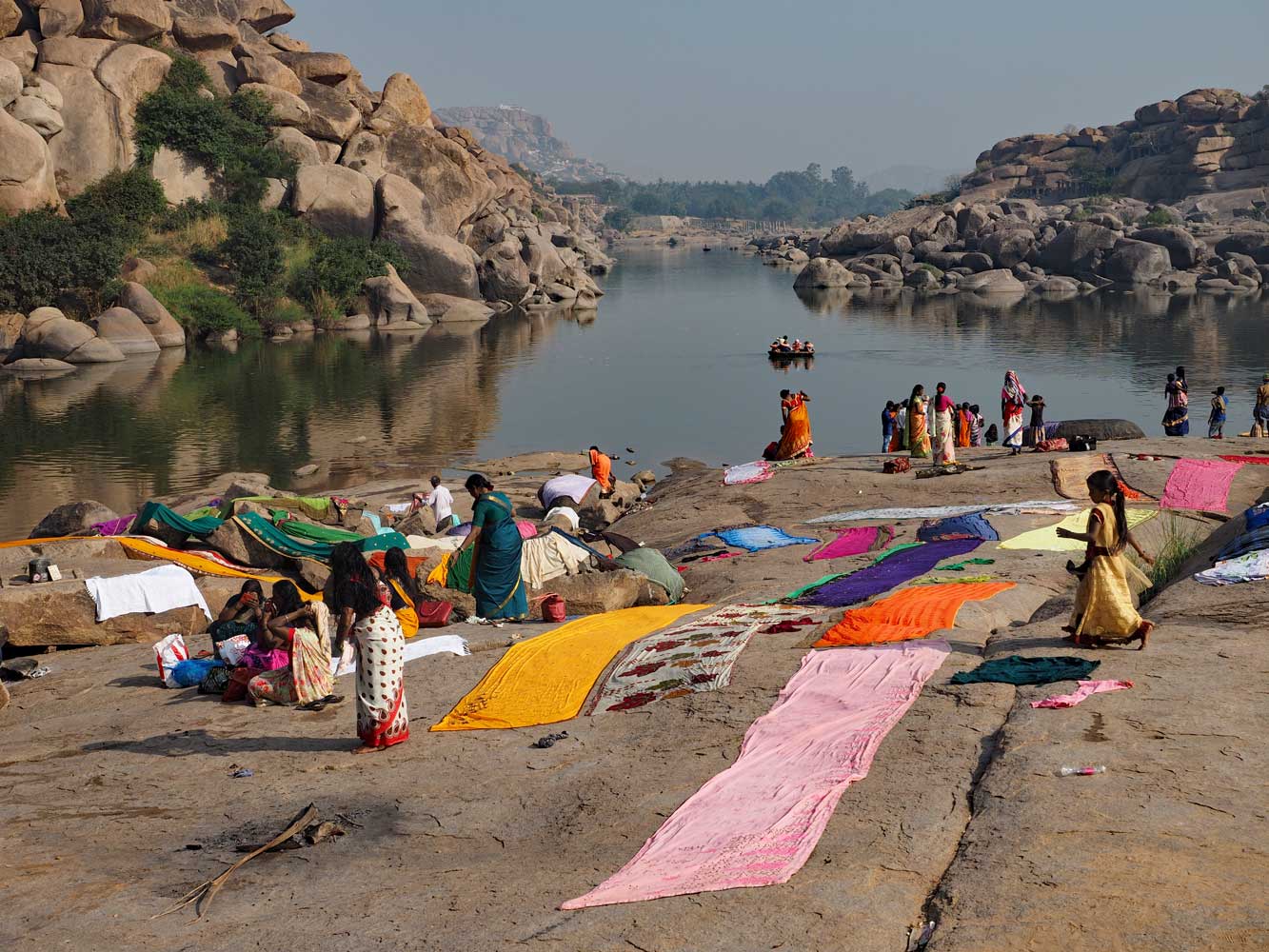
Morning wash beside the Tungabhadra River.
You can make out the white Hanuman Temple atop distant Anjanadri Hill.
26 January Hampi
I kept going back to the Mango Tree Restaurant each
morning for one of their Western set breakfasts, a bit of a novelty after only
having South Indian breakfasts in Chennai and Mysore. Today I did the grand tour
of Hampi, visiting the main sights of the Sacred and Royal Centers as well as a
host of places along the way in a big loop. I started by wandering northeast
about 2.5 kilometers to the 16th-century Vittala Temple, which has exceptional
decorations including stucco figures in good shape on the entry gopuram. Inside
the vast courtyard stands a curious stone chariot that represents Vishnu’s
vehicle and has a relief of Garuda inside. Small columns of the central temple
produce musical notes when struck by hand, but the authorities have banned
striking of the old columns and instead installed replica columns for tourists
to play with. There’s also a marriage hall with countless large columns. The
temple compound has much to see with detailed reliefs of elephants, lions, gods,
and other figures decorating nearly every surface of the shrines, gopuram, and
interior walls. To get in I had to purchase a Rs. 600 ($8.42) ticket—more than
ten times what Indians pay—that also covers the Royal Center if visited on the
same day. Nearby I walked down an old bazaar to a large Siva temple, well
decorated with stone reliefs. Continuing east I passed Pushkarani, a stone-lined
water tank with a decorative pavilion in the center.

Morning wash beside the Tungabhadra River.
You can make out the white
Hanuman Temple atop distant Anjanadri Hill.
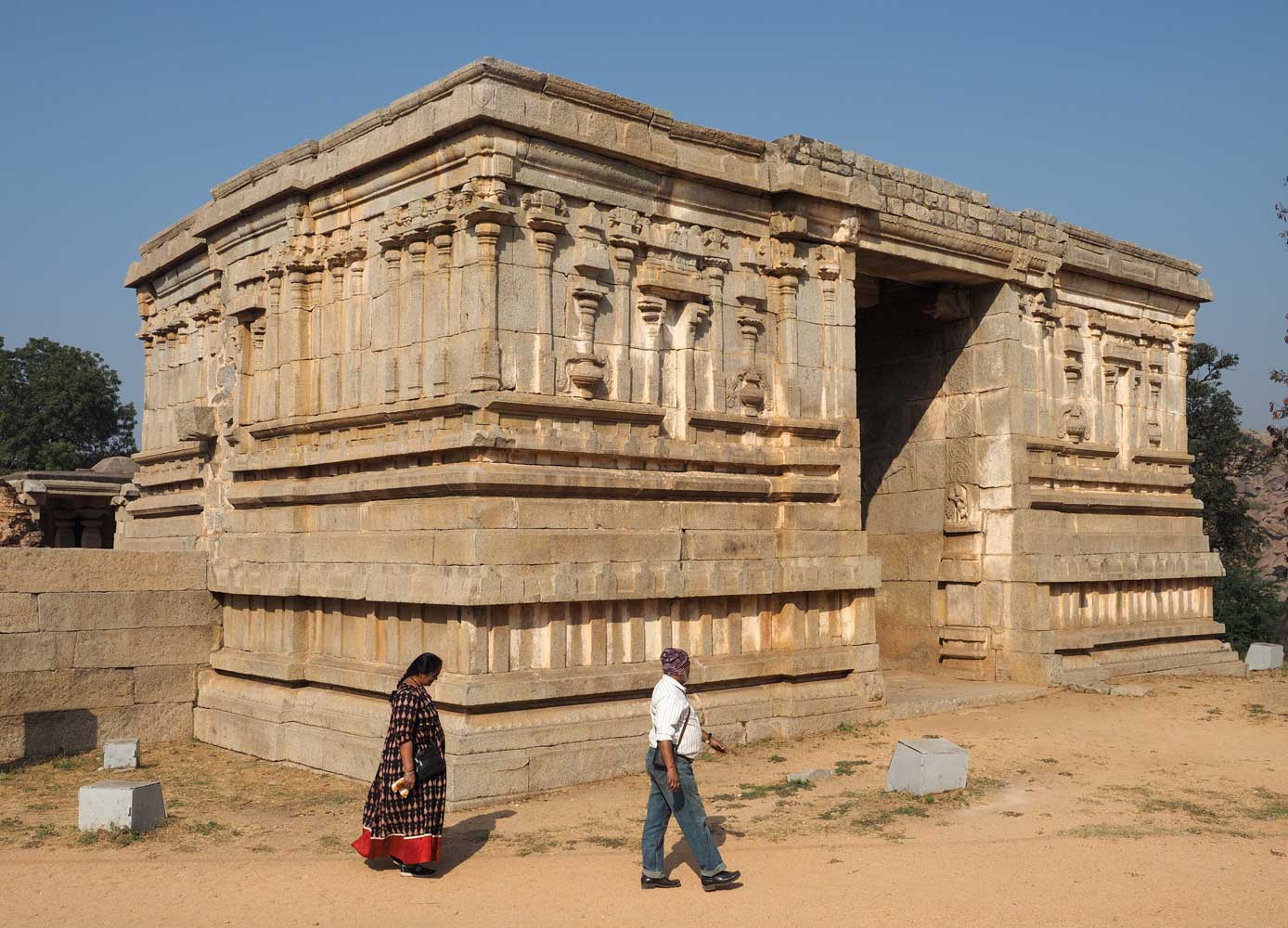
Entrance gate to Varaha Temple

Varaha Temple, despite its name, has a Nandi and yoni (lingam base) for
Shiva inside.

I pass many little temples and this tall pillar. The east gopuram of
Virupaksha Temple rises in the far distance.
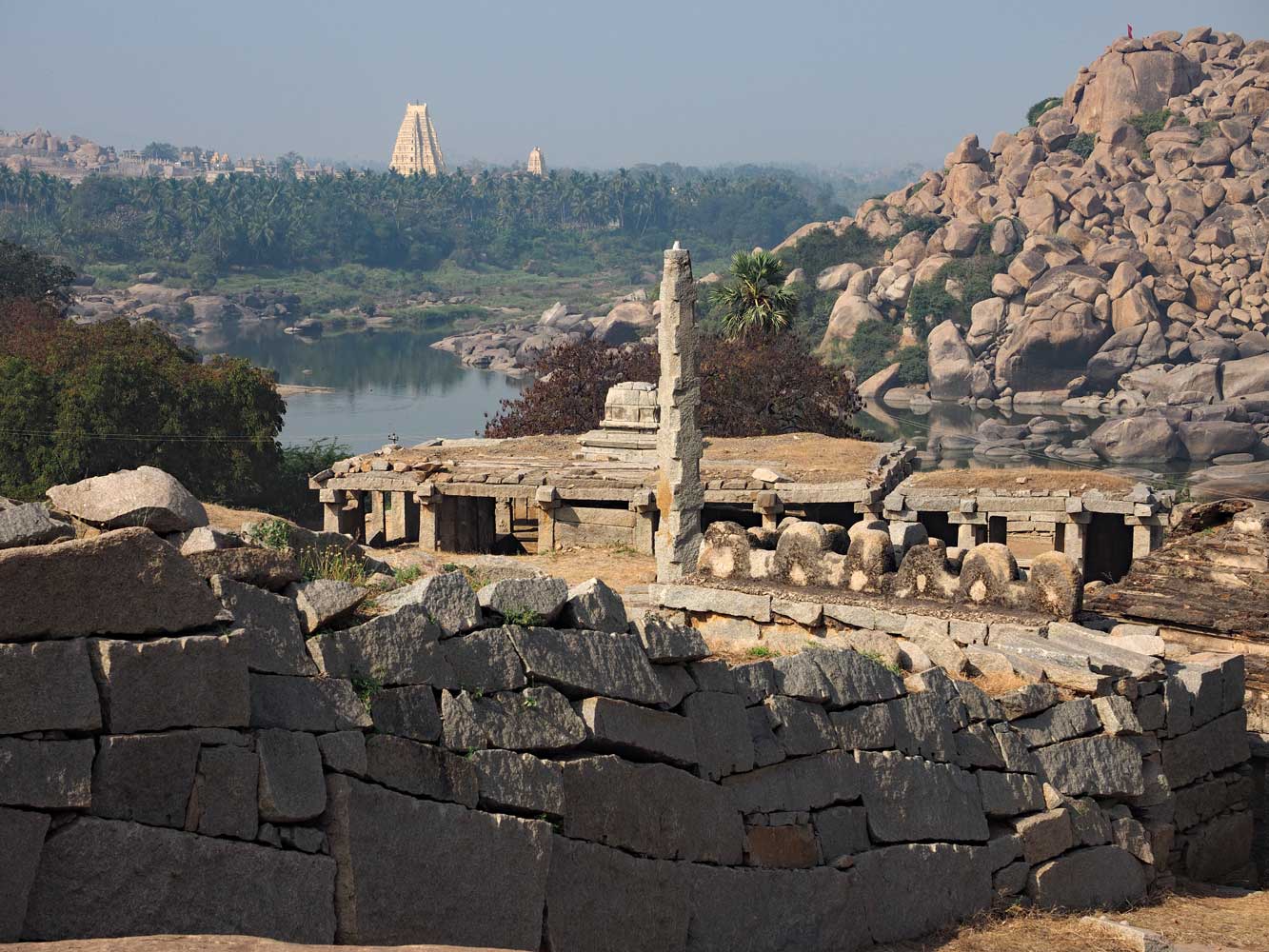
I climb a little hill to other temples and this view to the west.
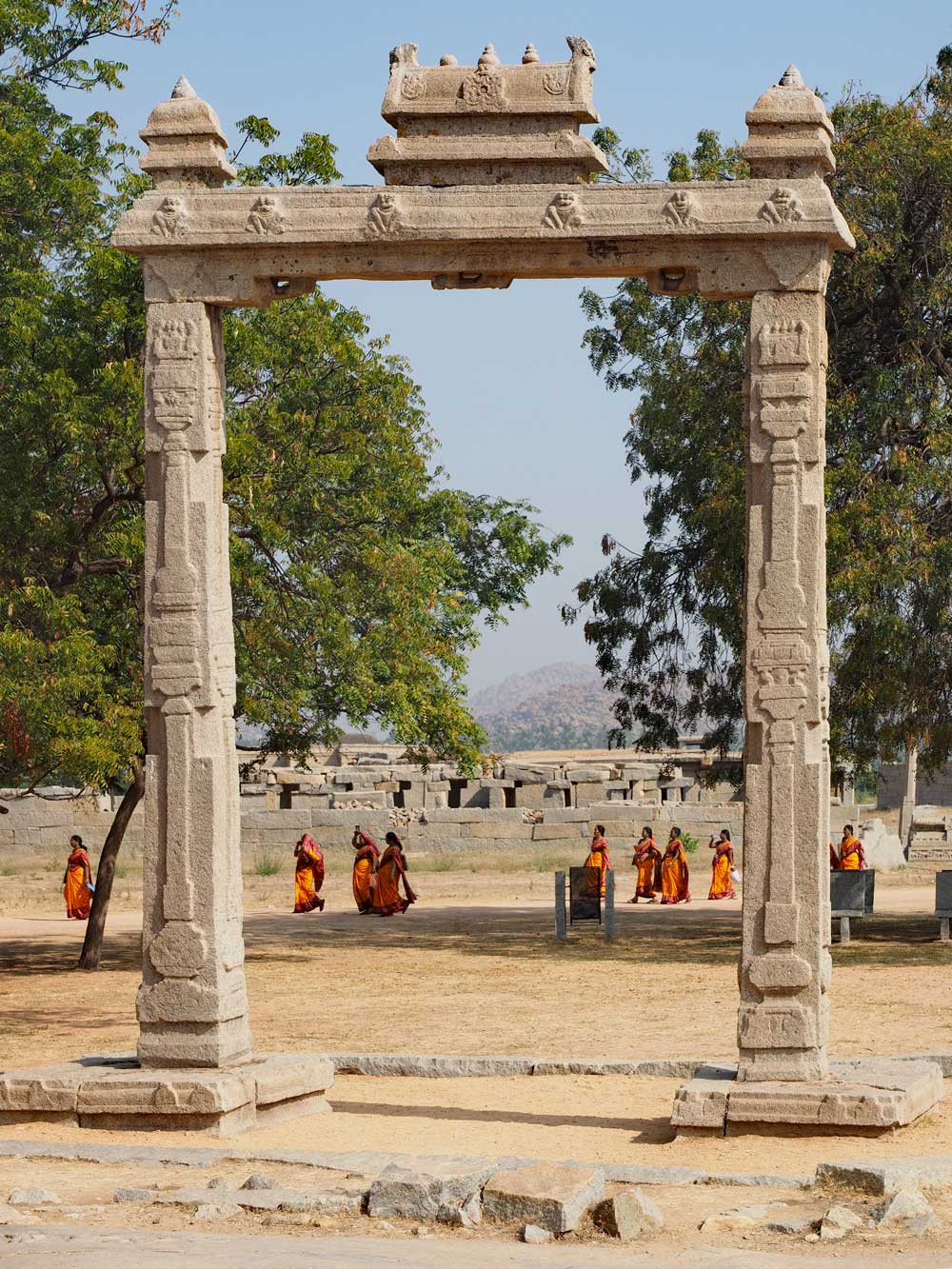
A fine gateway beside a time-worn temple

Ruined gateway near Vittala Temple

One of a great many reliefs on pillars just outside Vittala Temple
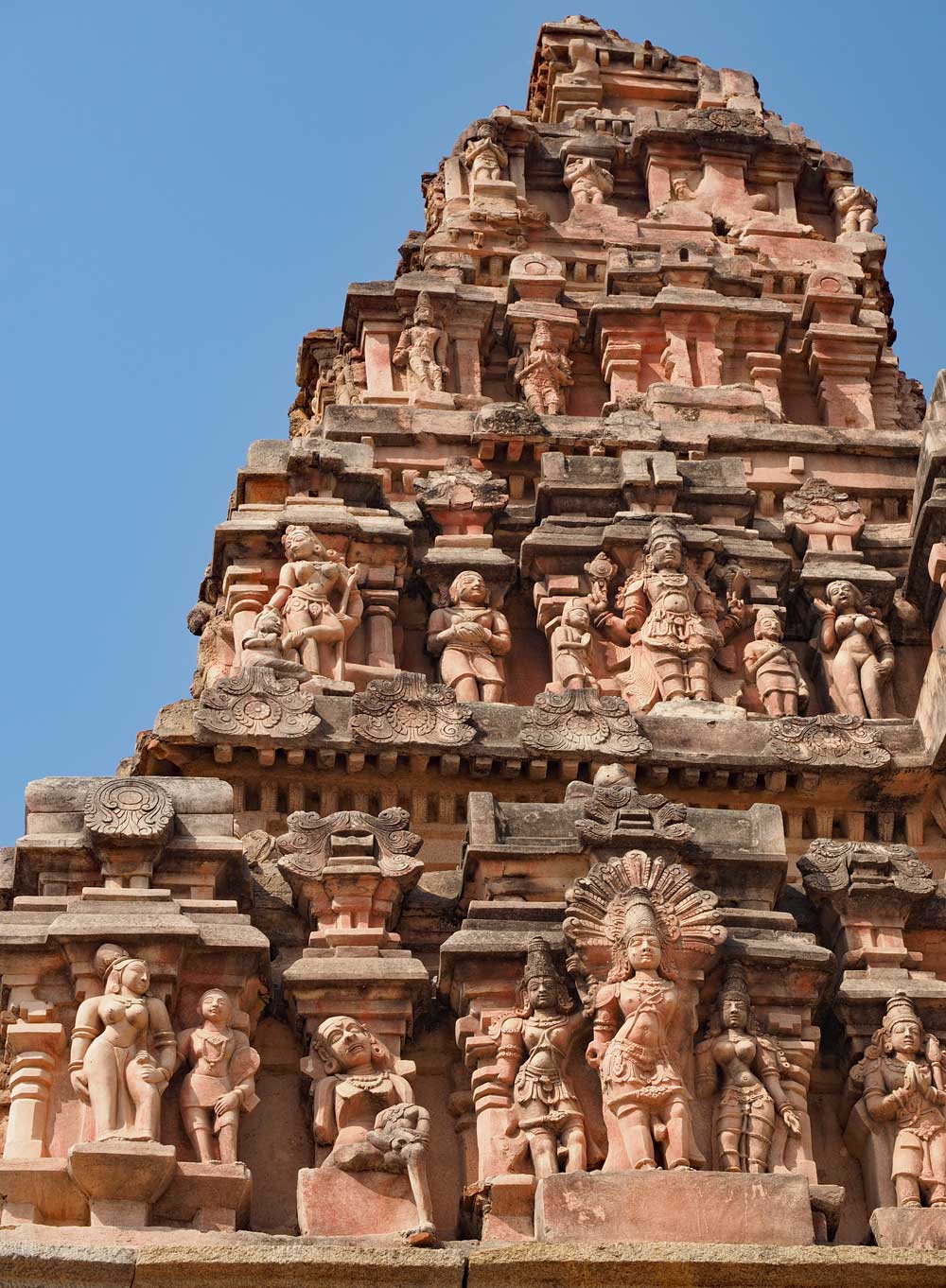
The main gopuram of Vittala Temple has exceptionally detailed stucco
figures.
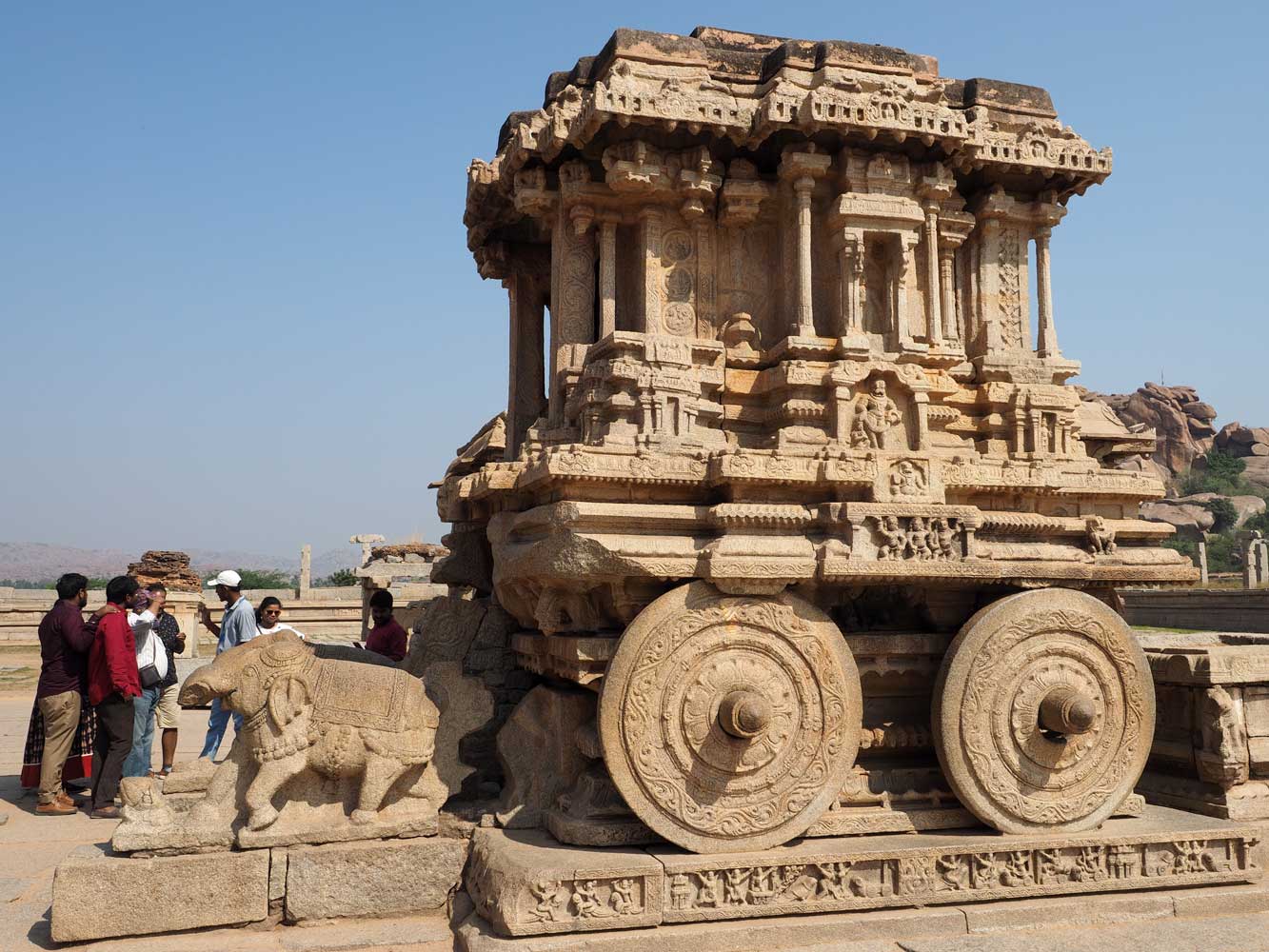
This ornate stone chariot stands as the centerpiece in the vast courtyard of
Vittala Temple. The wheels could once be turned!
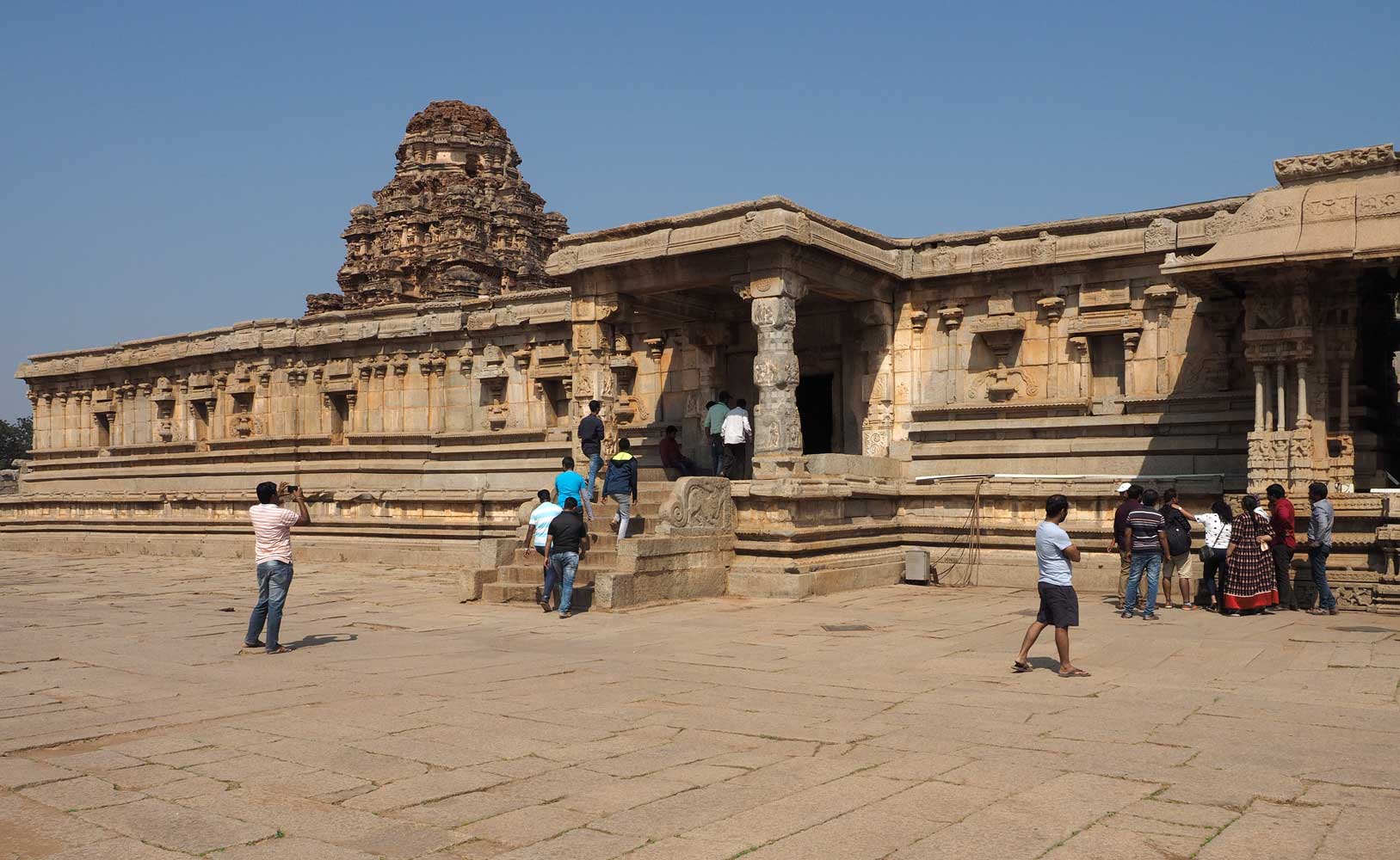
Side view of Vittala Temple with the tower that shelters the inner sanctum.
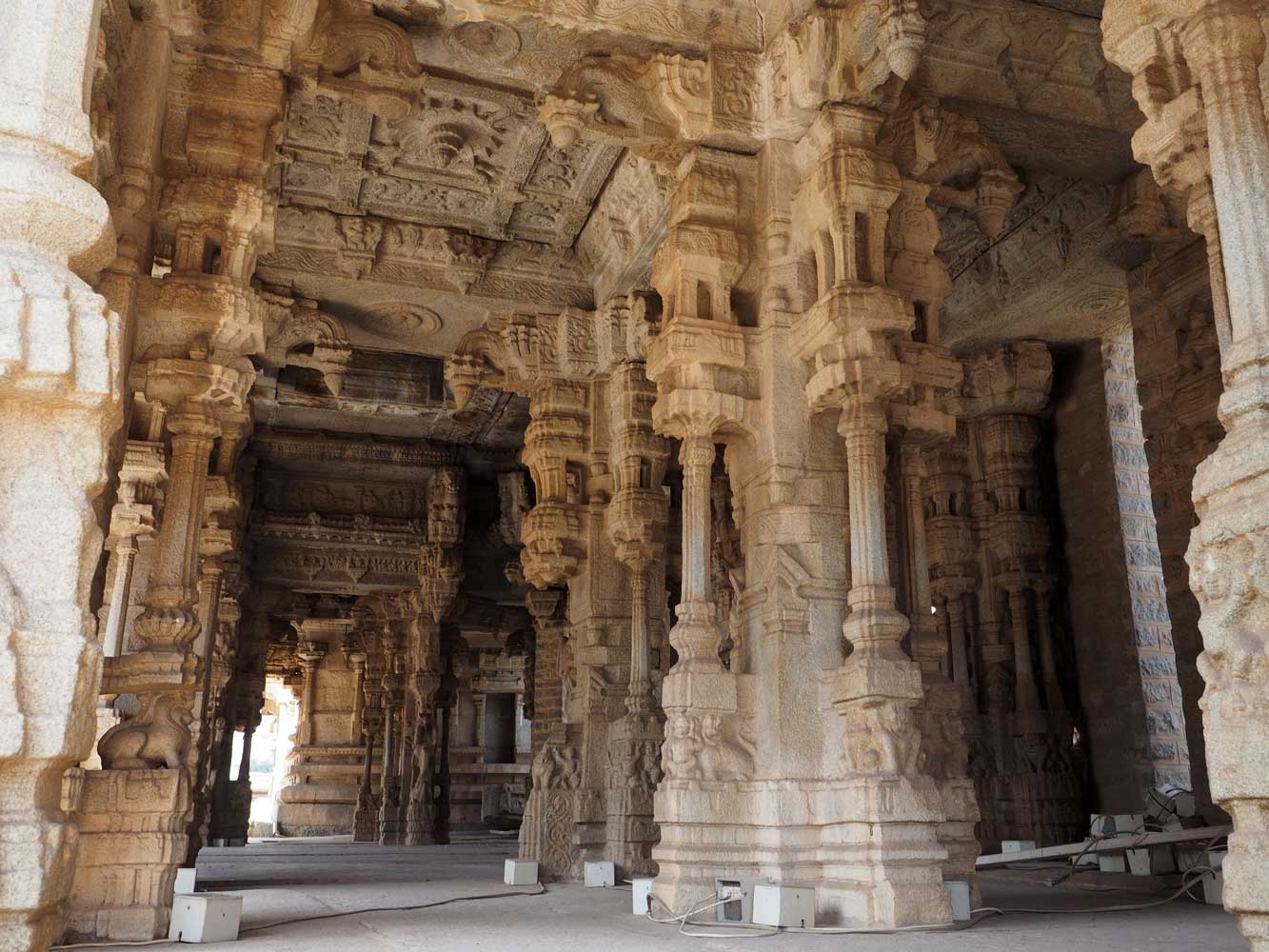
The lavishly decorated porch with musical columns in Vittala Temple
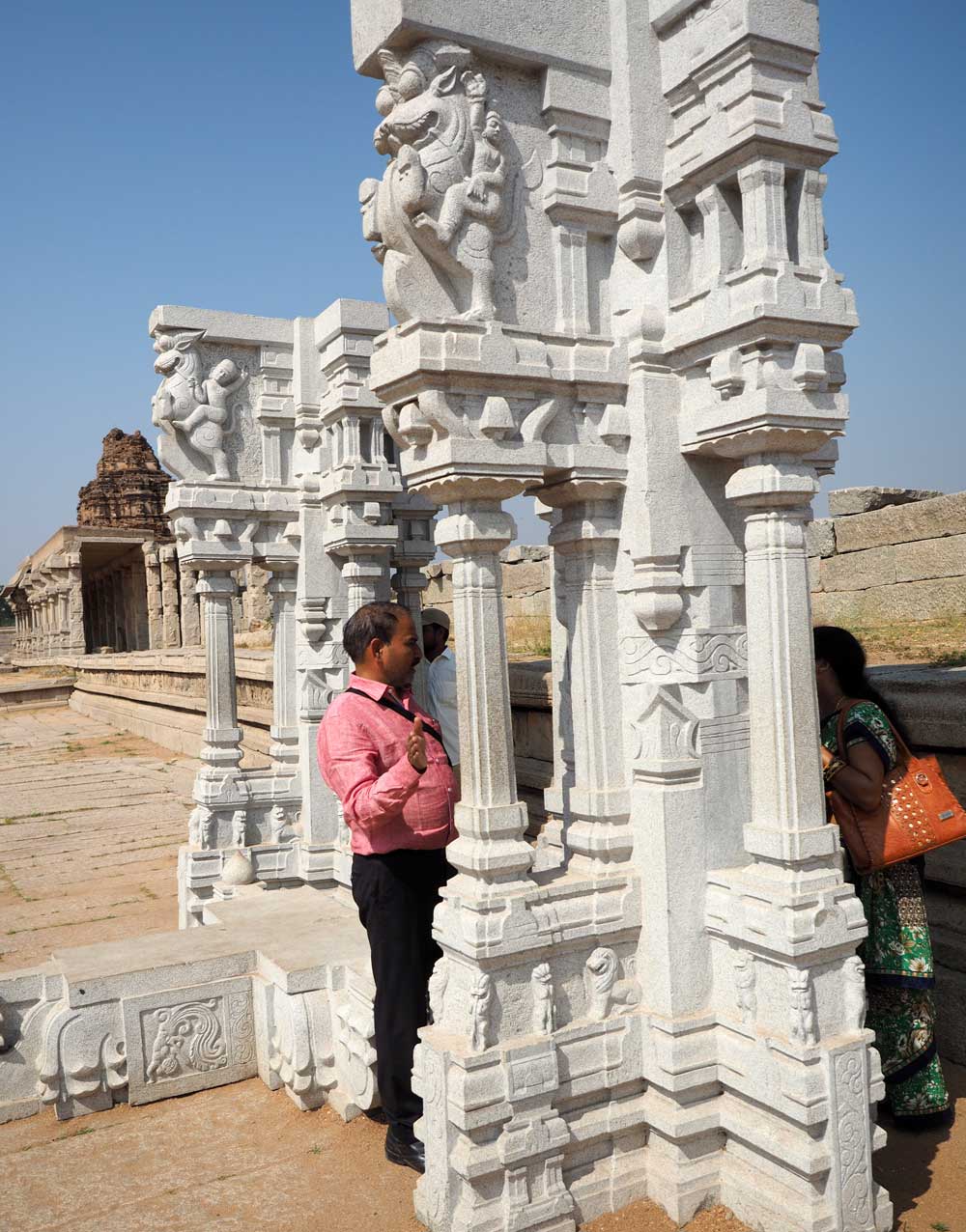
Tourists can try out these reproductions of the musical columns.
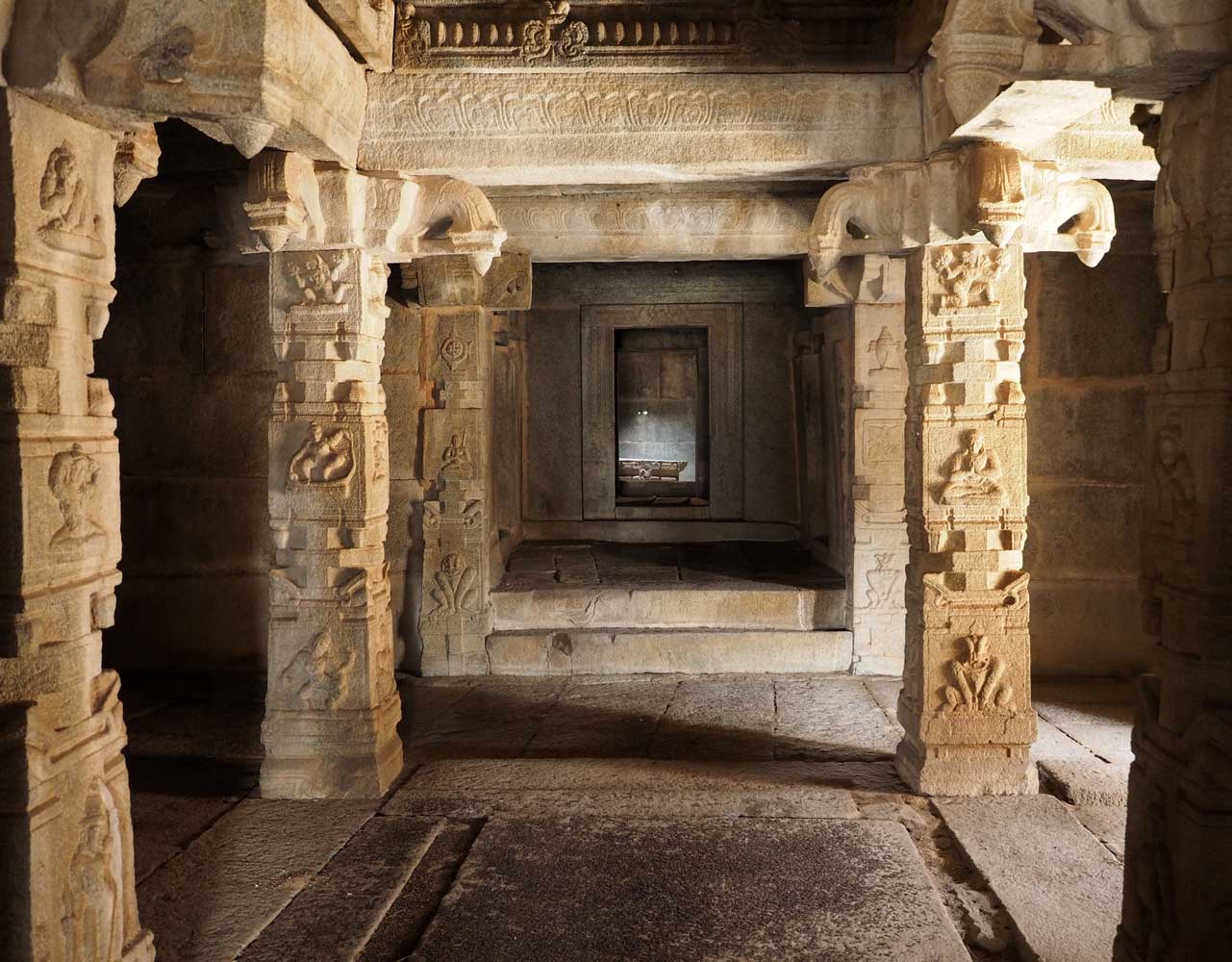
Inside the Shiva temple, a short walk down an old bazaar from Vittala Temple

Water tank east of Vittala Temple
At a road junction I downed a liter of cold water, then got a three-wheeler to take me around to the Royal Center in the south. I got off at the Queen’s Bath, plain on the outside and a paradise of Indo-Islamic architecture and decorative stucco inside. The queens must have been delighted to have such a wonderful and private place to bathe and relax in the old days!
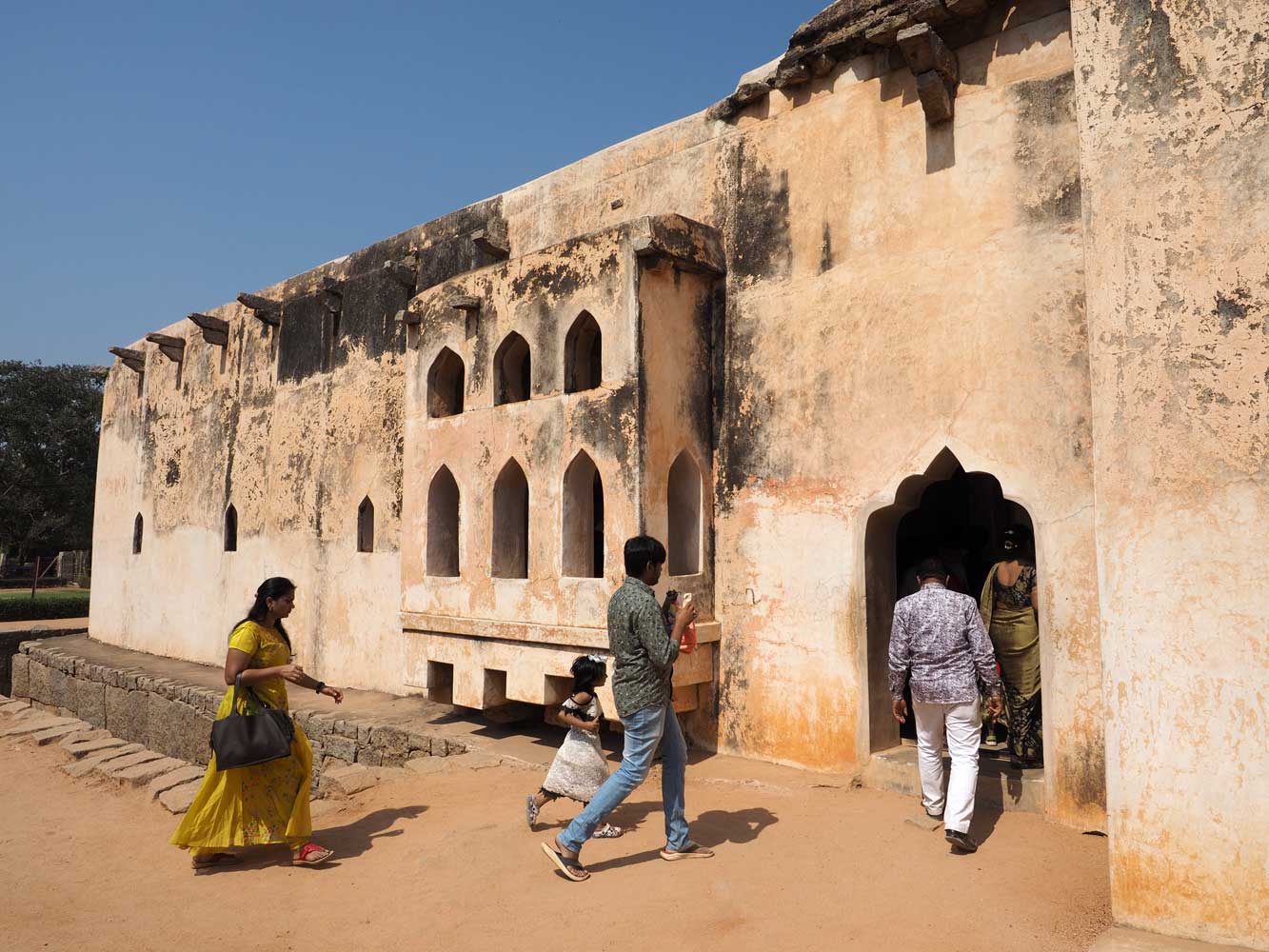
Stepping inside the Queen’s Bath
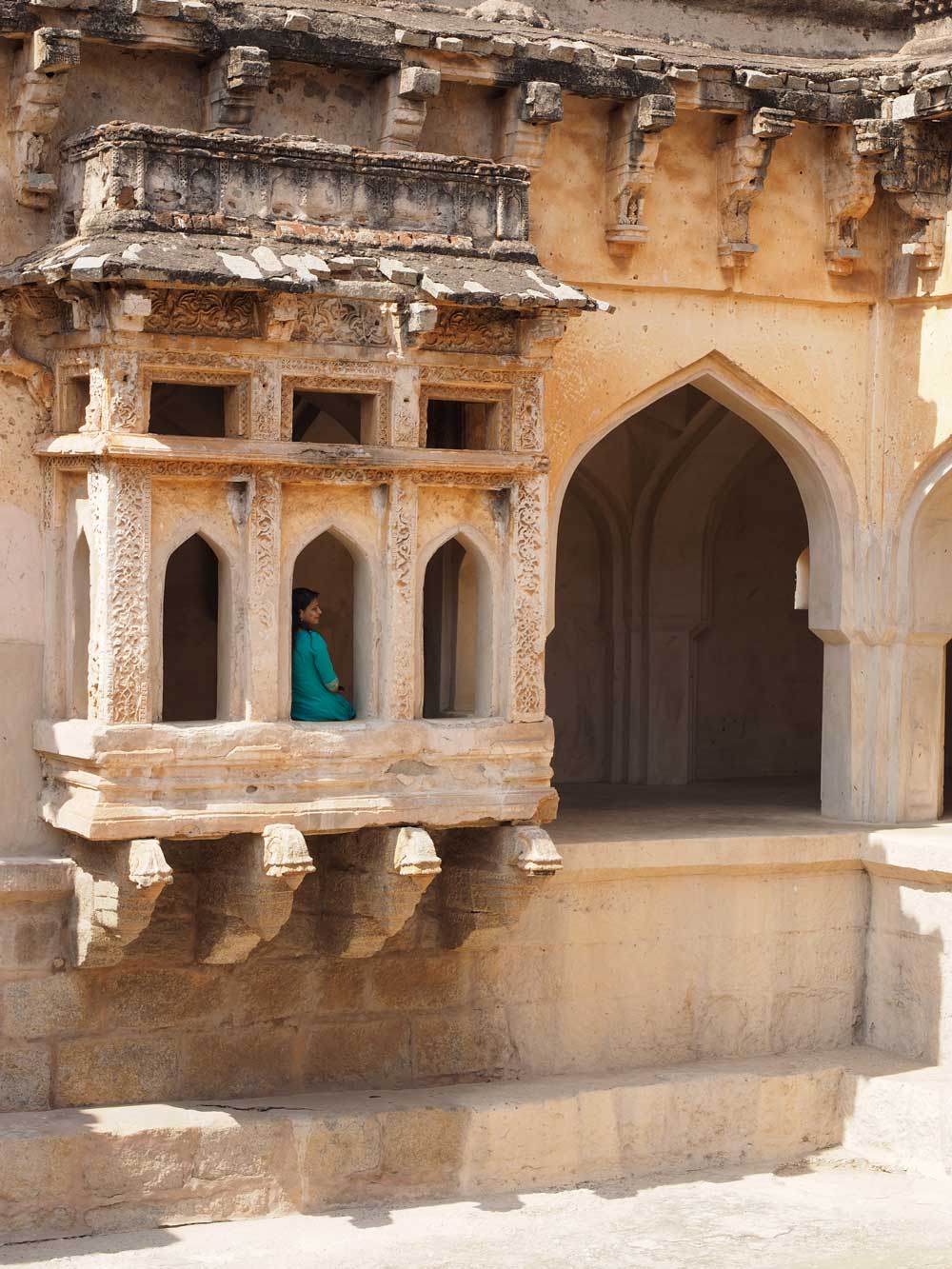
Water no longer fills the central pool, but the setting is still pleasant.
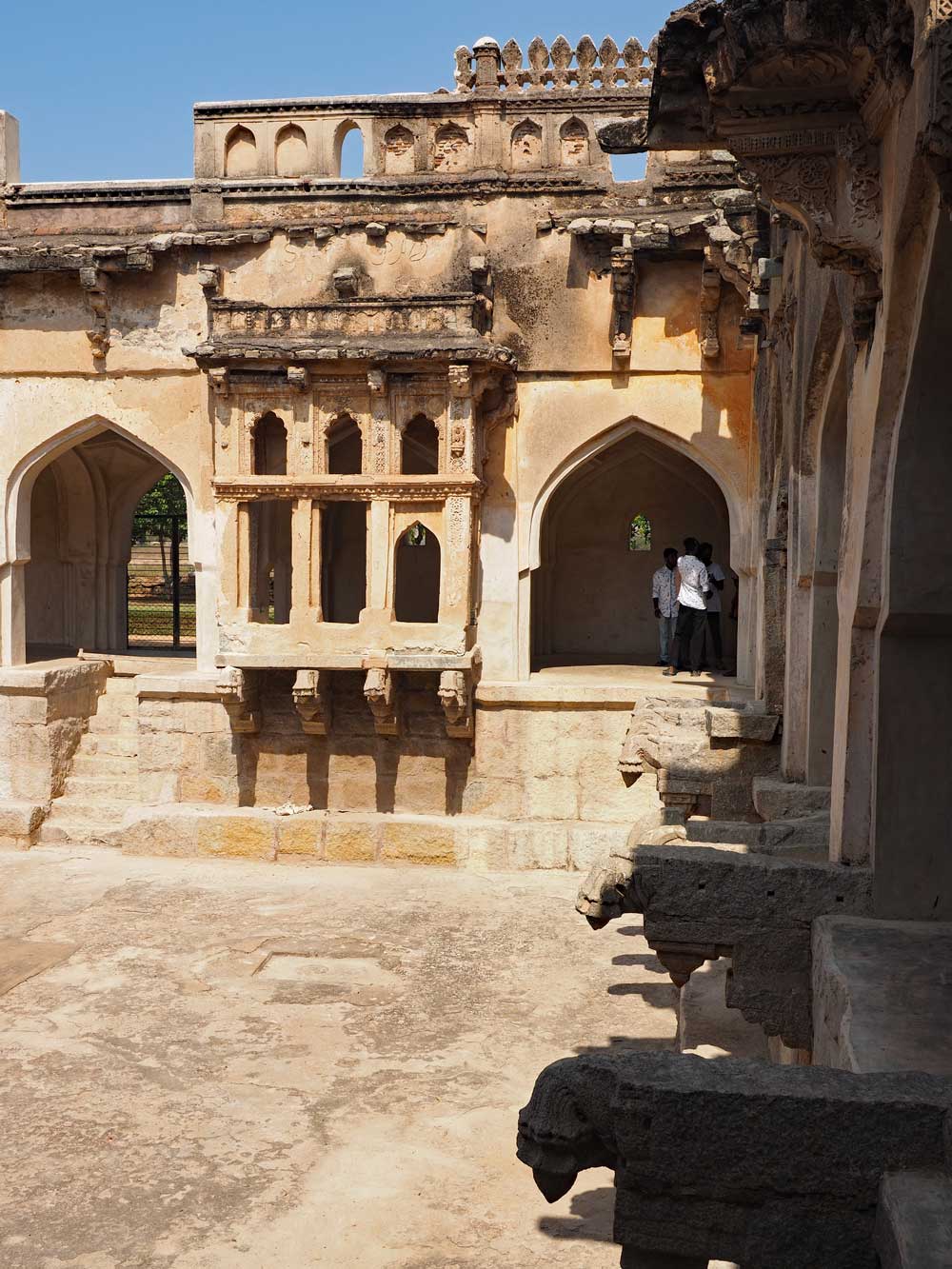
Some of the decorative stucco work survives.
I found my way around to the main entrance of the Zenana Enclosure, well protected by a high wall and several lookout towers for the safety of the ladies who lived within. Of the residences, only the beautiful two-story Lotus Mahal survives. Behind the Zenana Enclosure I visited the Elephant Stables, one of the largest and grandest buildings of Hampi. Each elephant had its own chamber, shaped much like those of Islamic tombs. Ruins of a two-story building atop the stables probably provided a place for the royal family to watch their elephants in action. Two plain buildings nearby house stone statues and other museum exhibits. I continued down a dirt road past the stables to a series of temples and an ancient gate.
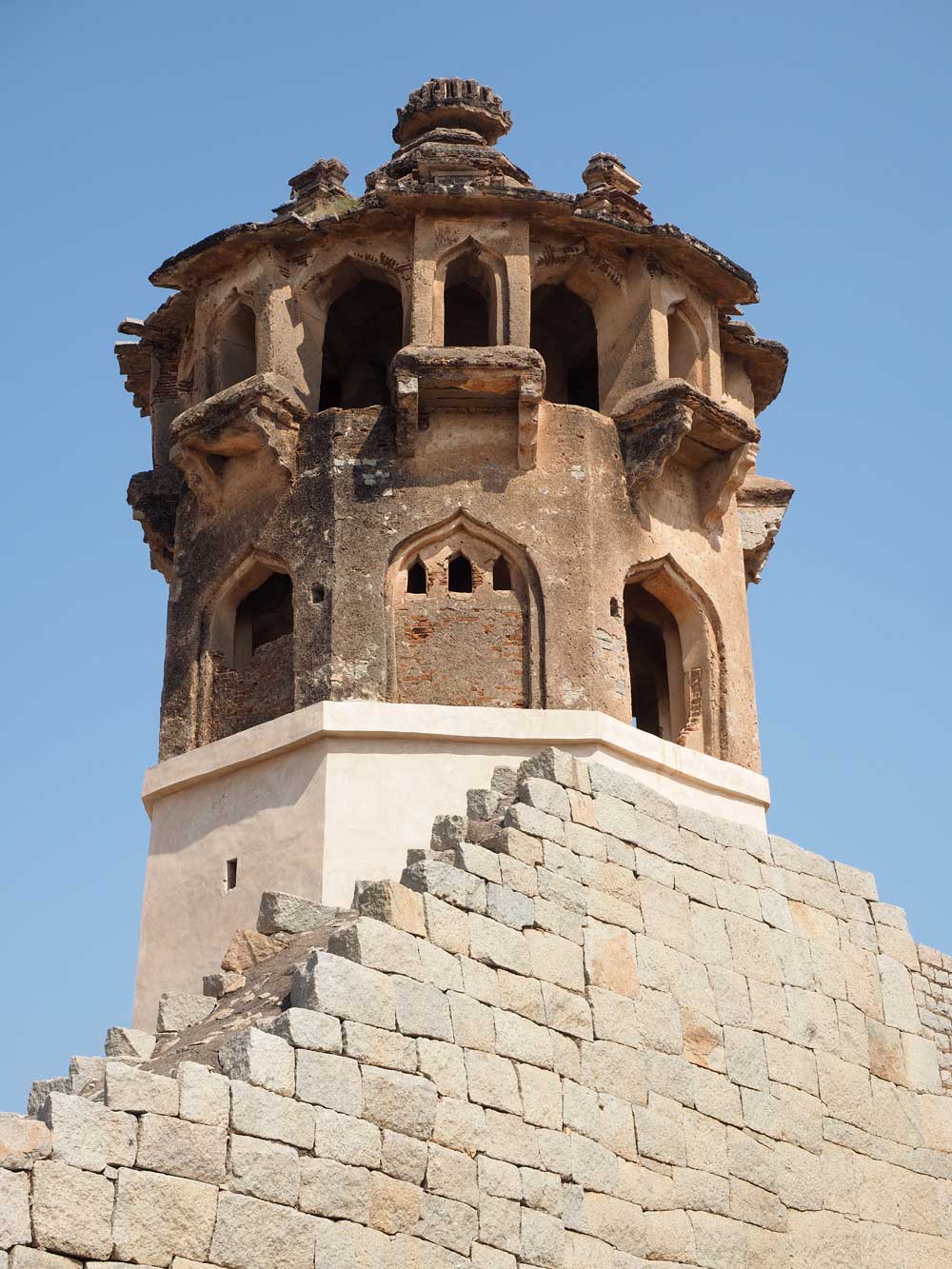
One of the watchtowers and section of high wall that protected the Zenzana
Enclosure
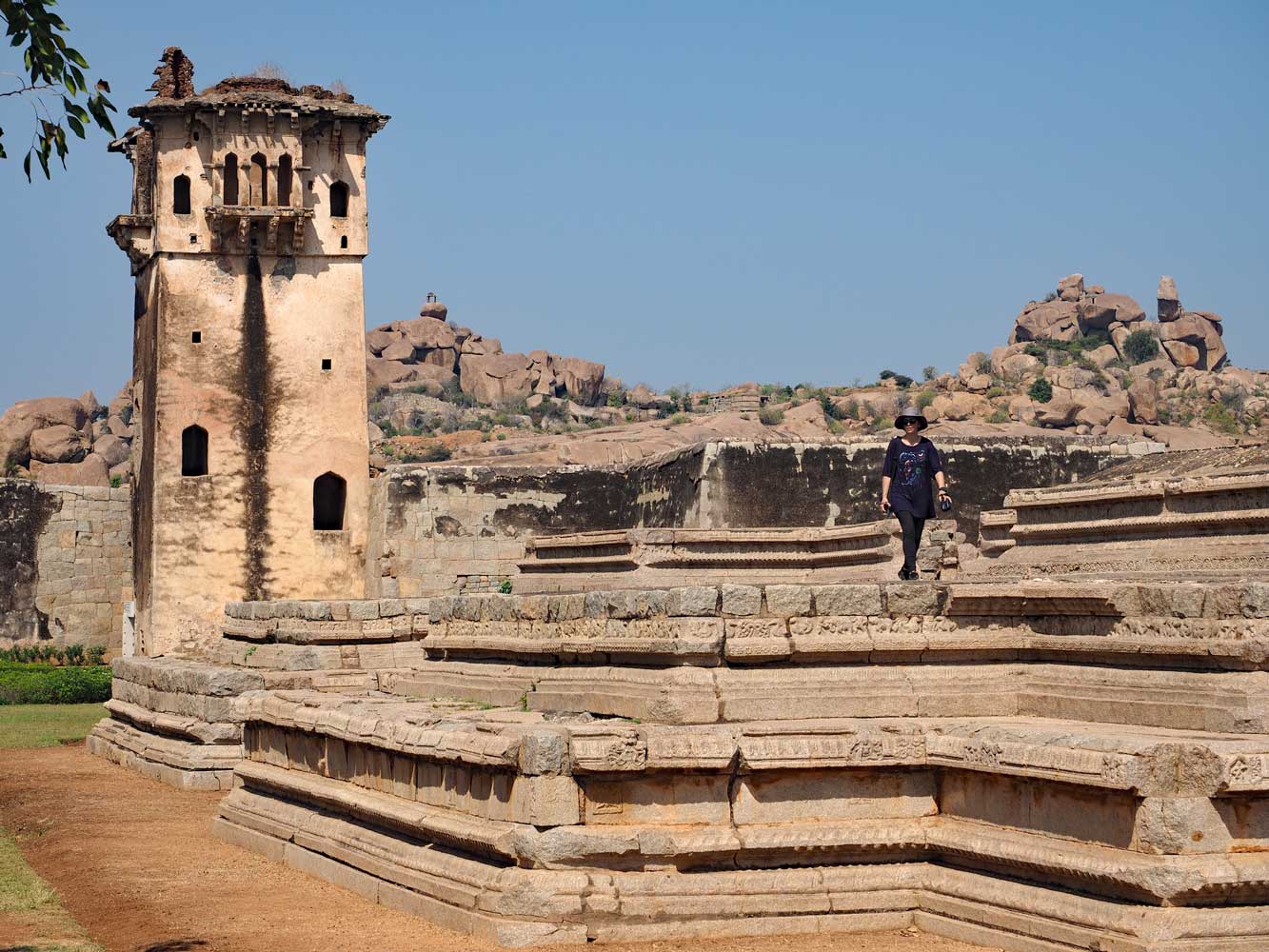
Another watchtower and a platform that once supported a palace building in
the Zenzana Enclosure
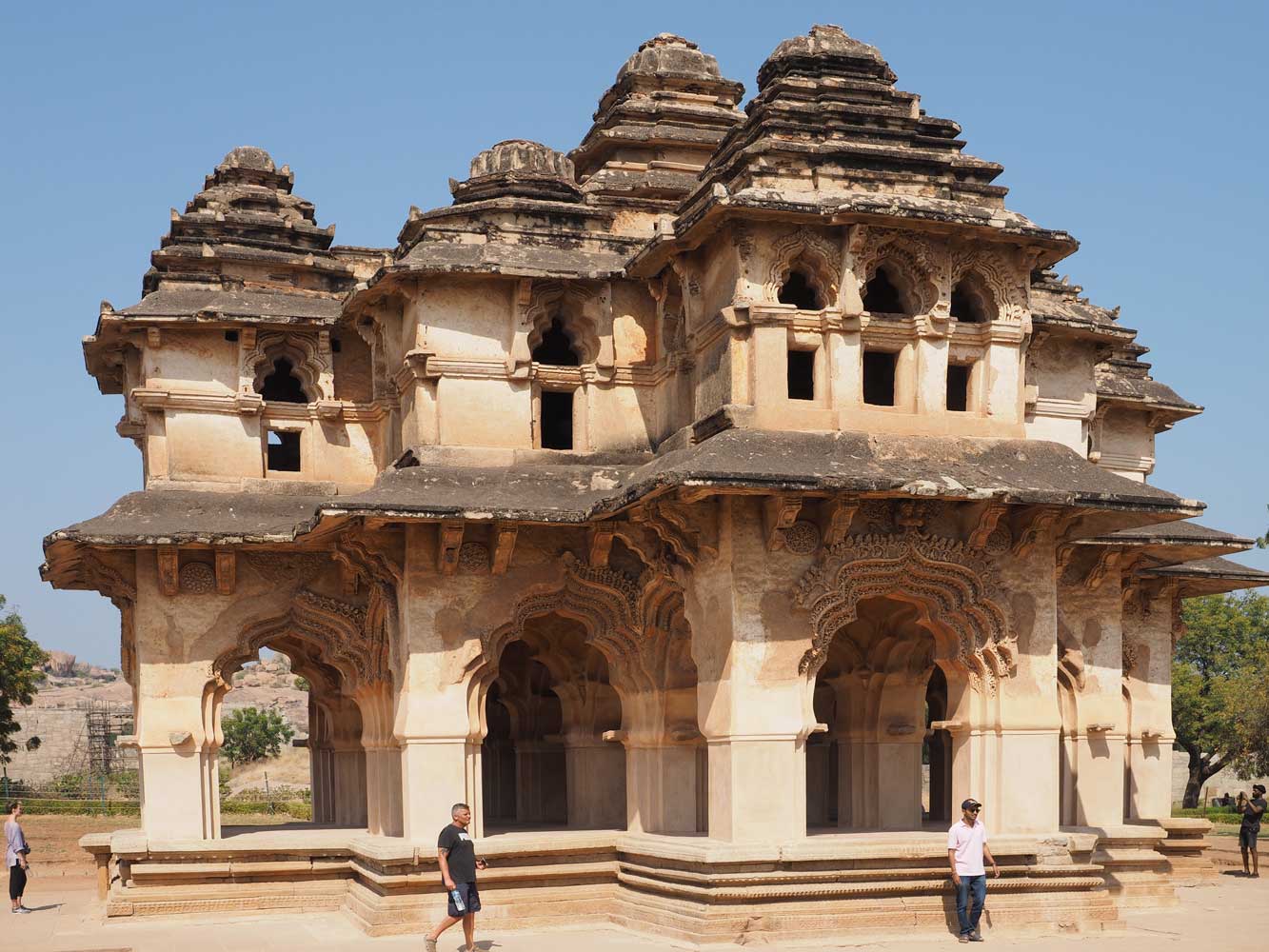
Visitors cannot go to the upper story of Lotus Mahal where ghosts might be
residing.

Stucco work above one of the many arches in Lotus Mahal
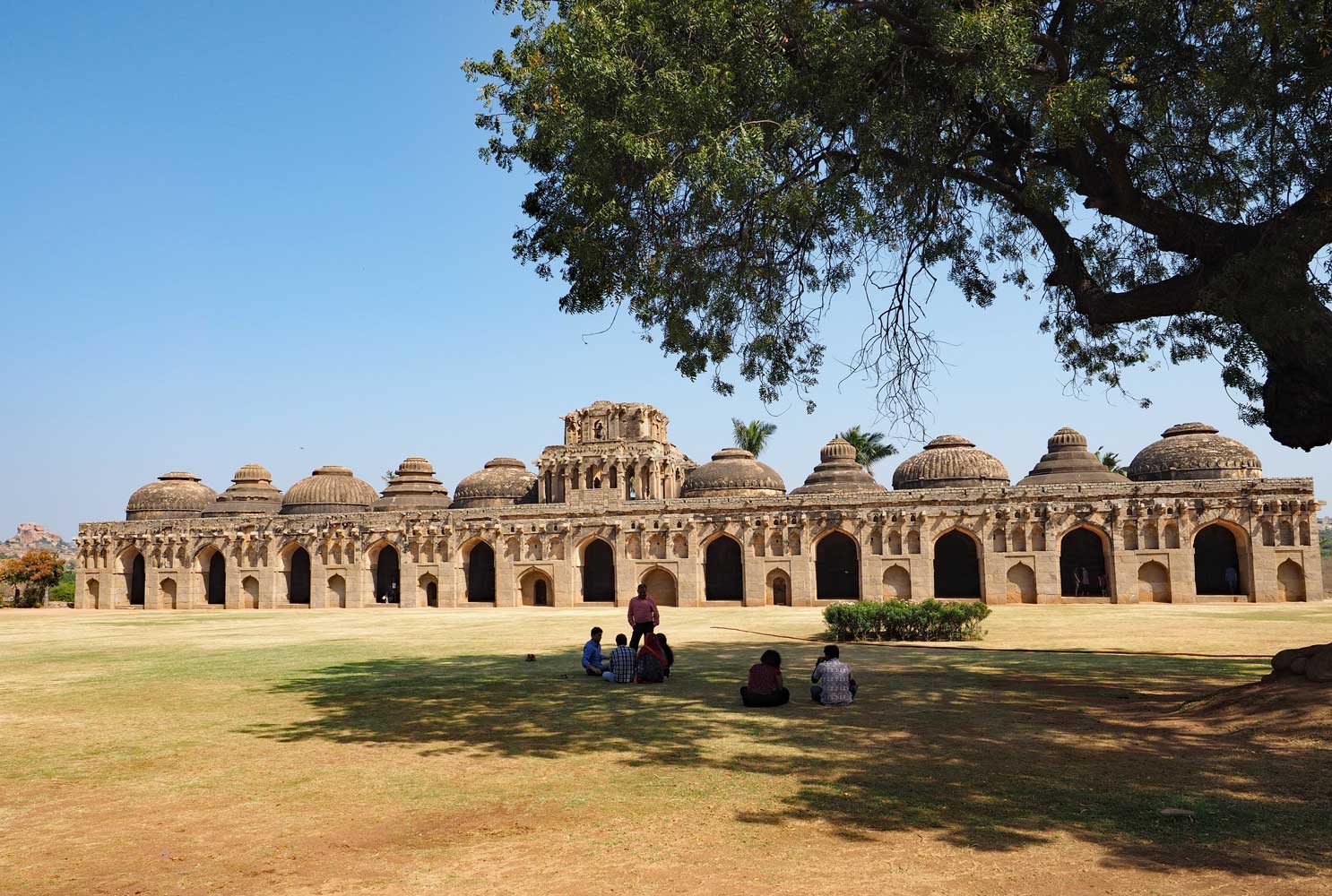
Elephant Stables
Hazarama Temple also stands in the Royal Center with extensive reliefs of the Ramayana story on the main building and its high walls. Inside I found carved columns of relatively rare black stone. Much of the Royal Center consists of vast platforms that probably once held wooden buildings. I also came across an underground passage and room, then a beautifully preserved stepped bath of black stone. Mahanavami Diiba, used by the royalty as a viewing area during festivals, has three tiers and a wealth of stone carvings of elephants, camels, horses, and religious scenes.
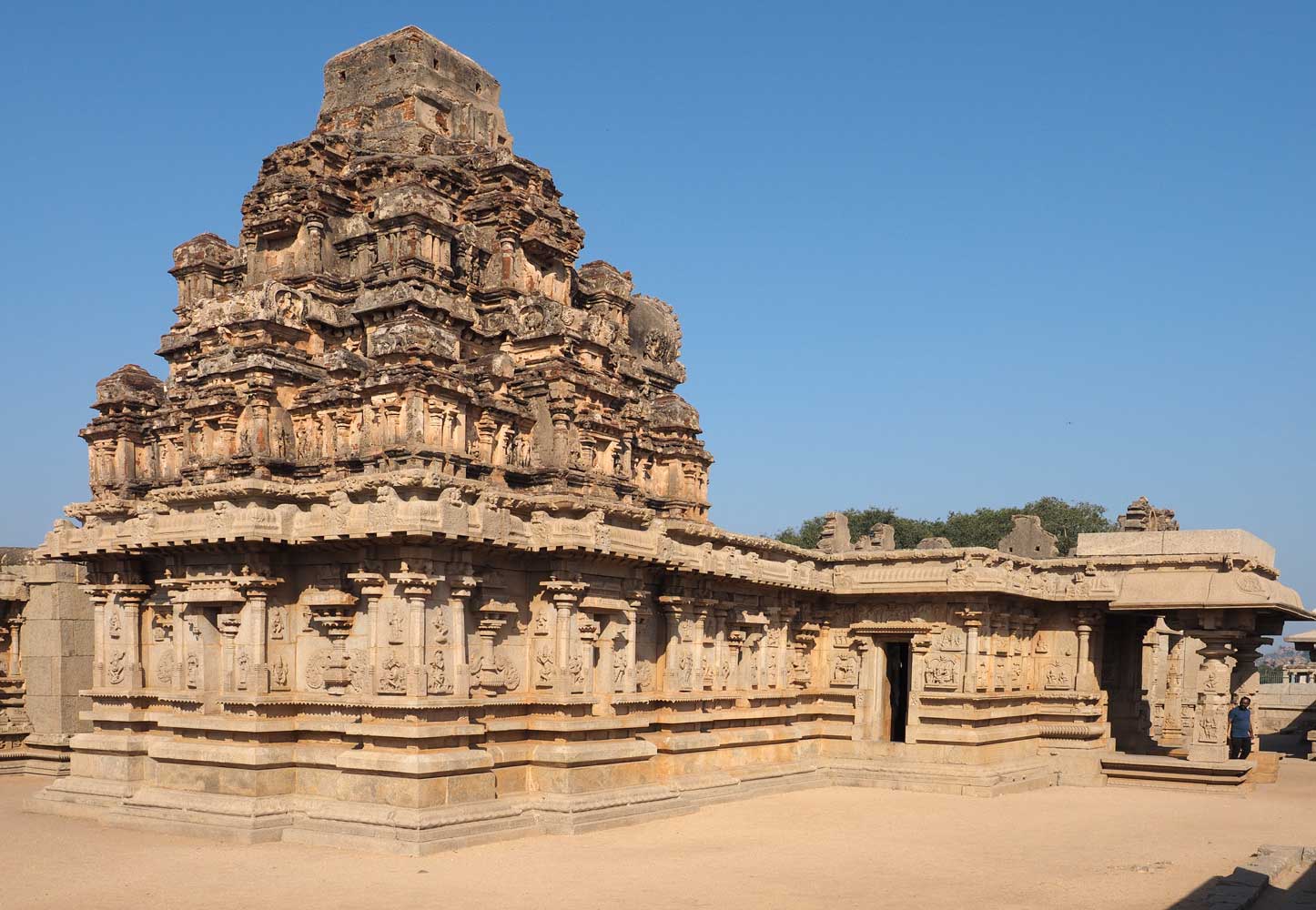
The 15th-century Hazararama Temple honors Vishnu in his aspect as Lord Rama.
Friezes of the Ramayana story wrap around the main shrine in three tiers.
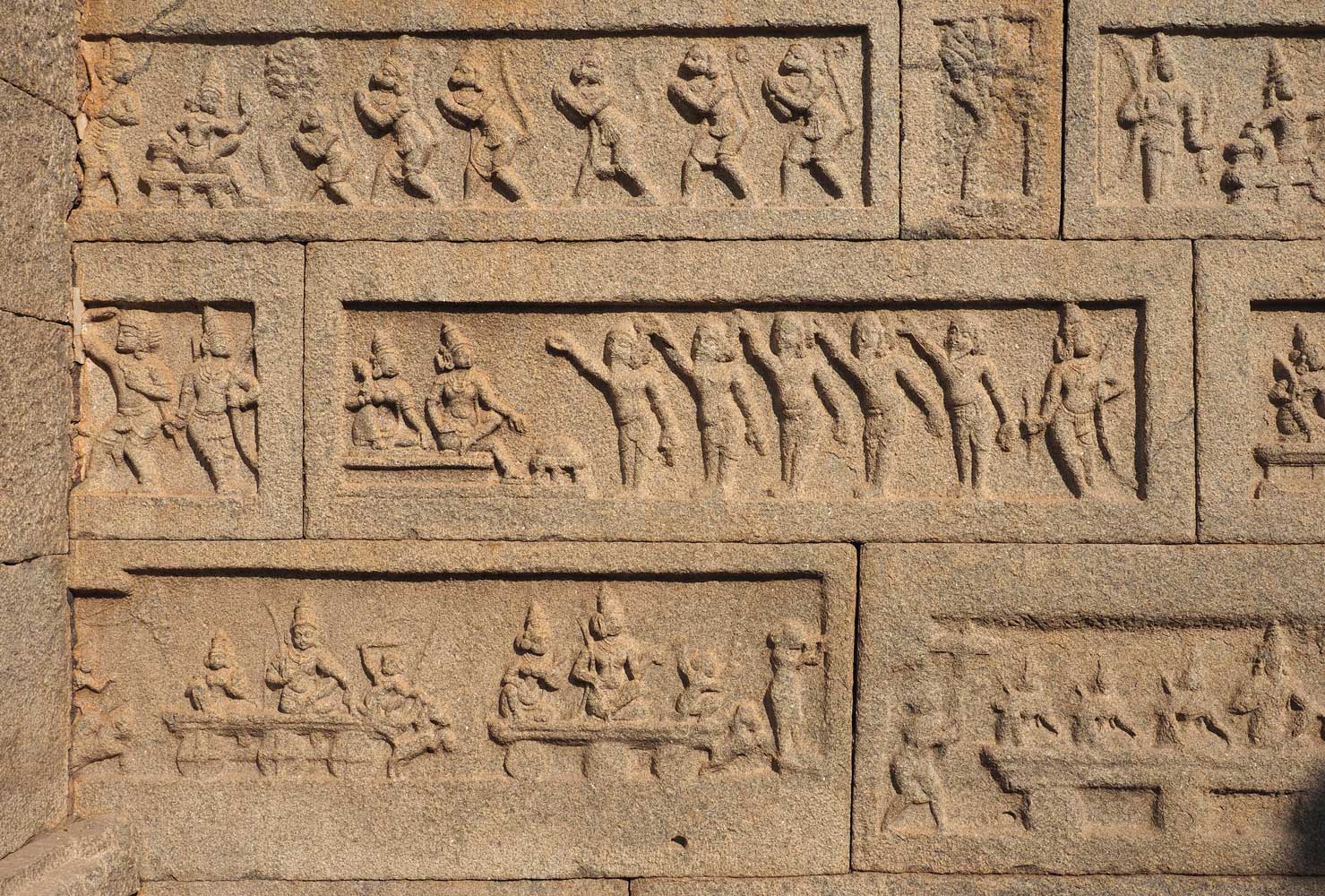
The wall that encloses Hazararama Temple also illustrates stories.
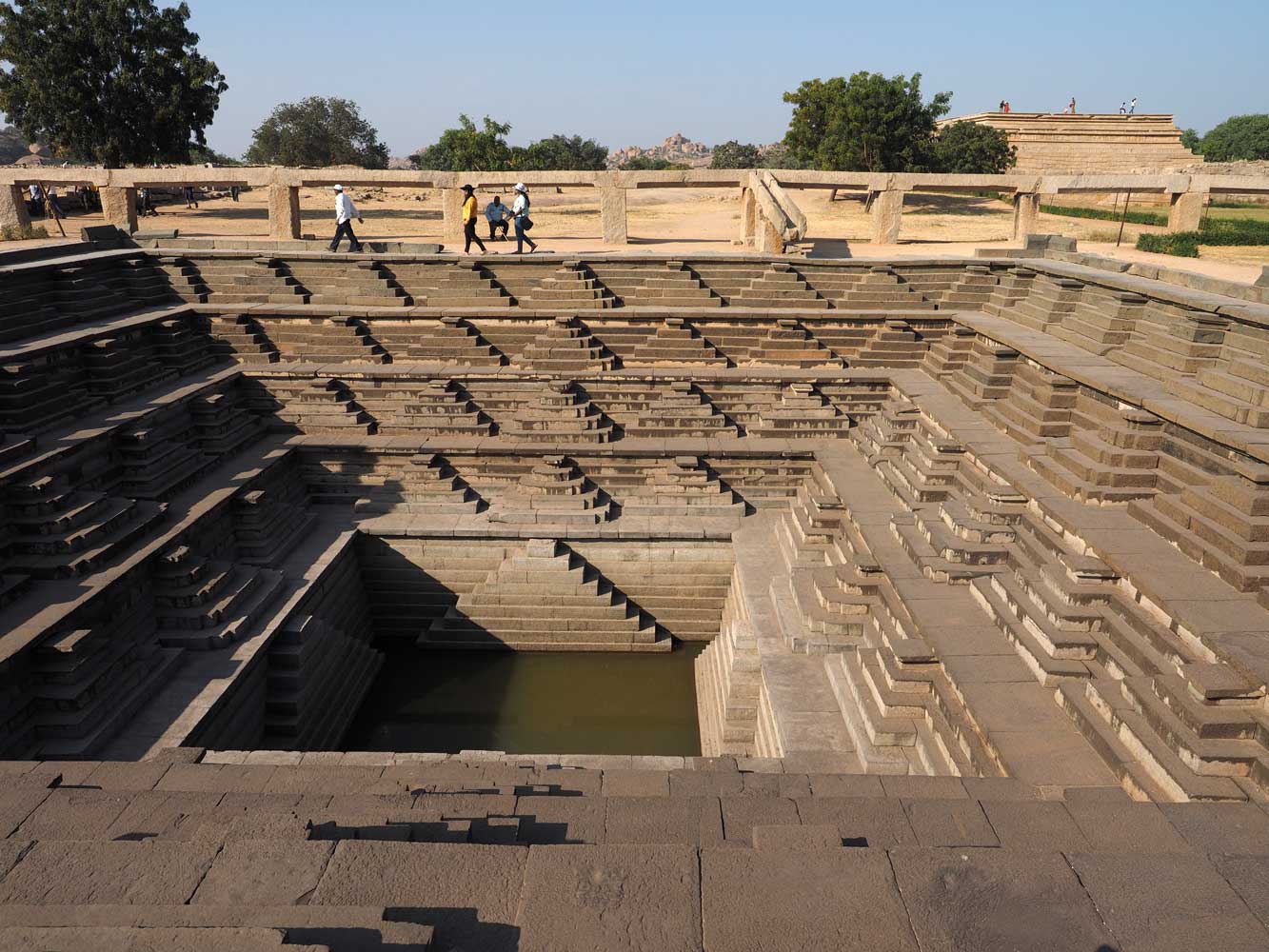
Stepped tank of dark stone south of the Mahanavami Diiba (visible in the
distance on the right)

Climbing up onto the Mahanavami Diiba

Scenes on the Mahanavami Diiba
Now the day had gotten late and the sensible thing would be to get a three-wheeler back to Hampi Bazaar. Instead I decided to hike, starting down a dirt road near the entrance of the Zenana Enclosure, forked right (signed for Hampi Bazaar) through a banana plantation, dropped to another dirt road, turned right a bit, then left into vegetation. Along the way I passed a small temple and scattered square stone pillars. Maps.me program showed the trails, accurately for the most part. I had to hop stones across an irrigation canal, then passed a stone-stepped path up the boulder-strewn Matanga Hill; I was tempted to detour to the summit and its small temple, but that likely would have been too much with the day getting short. The overgrown main path turned west and entered the ancient Krishna Bazaar, which has a large water tank with a decorative pavilion in the middle. I came to the road in front of Krishna Temple, one of the largest in Hampi, and went inside to see the courtyard and buildings. The east gopuram has fine stucco sculptures, but scaffolding mostly blocked the view. Lastly I followed the road back to Hampi Bazaar and went for a spinach pizza at The Mango Tree Restaurant.

A ‘duck on a
rock’ rises above the banana plants.

A wide and
well-built stone path goes up the south side of Matanga Hill, but few people use
it. I will come back in two days and take this trail.
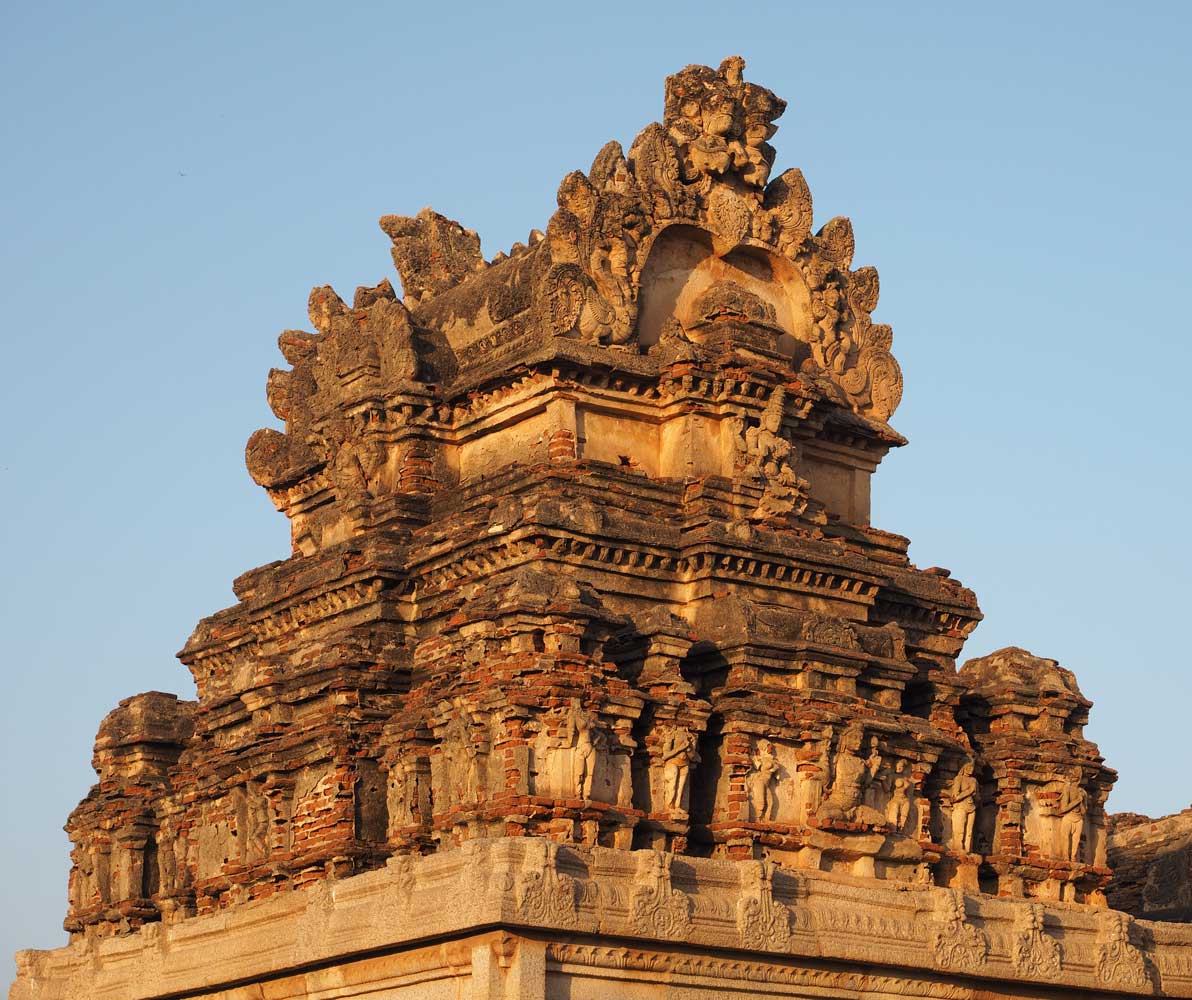
Decorative
tower above a shrine at Krishna Temple

Well-preserved
stucco atop a shrine at Krishna Temple
On to Hampi—Part 3
Back to beginning of “Backpacking 2020: India, Singapore, and Philippines”